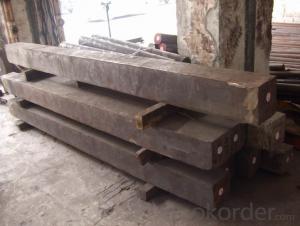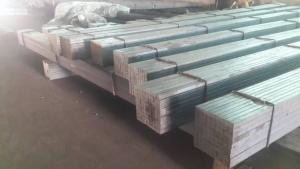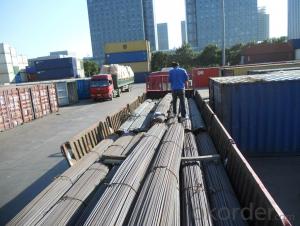14mm*1.54kg/m square bar for construction
- Loading Port:
- Tianjin
- Payment Terms:
- TT OR LC
- Min Order Qty:
- 25 m.t.
- Supply Capability:
- 100000 m.t./month
OKorder Service Pledge
OKorder Financial Service
You Might Also Like
Product Description:
There are two types of Square Bar, one is hot rolled square bar and other one is cold drawn square bar. Our principal products is hot rolled square bar. We dedicate to products with material Q195 and Q235. We offer products with high quality and low price.
Specifications of Hot-rolled Square Steel Bar:
-Standard: GB,
-Grade: Q195/Q235 or equivalent.
-Chemical Composition:
Standard | Grade | Element (%) | ||||
C | Mn | S | P | Si | ||
GB | Q195 | 0.06~0.12 | 0.25~0.50 | ≤0.050 | ≤0.045 | ≤0.30 |
GB | Q235B | 0.12~0.20 | 0.30~0.70 | ≤0.045 | ≤0.045 | ≤0.30 |
-Mechanical Properties:
Mechanical Properties | Grade | Steel diameter(mm) | |||
≤16 | 16~40 | 40~60 | 60~100 | ||
Yield Point Δs/MPa | Q195 | ≥195 | ≥185 | - | - |
Q235 | 235 | 225 | 215 | 205 | |
Tensile Strength | Q195 | 315~390 | |||
Q235 | 375~500 | ||||
Elongation δ5% | Q195 | ≥33 | ≥32 | - | - |
Q235 | 26 | 25 | 24 | 23 | |
Measures of Hot-rolled Square Steel Bar (Big measures):
(Section of Hot-rolled Square Steel Bar)
-Length of a side and Theoretical weight of Square Bar (Big measures).
Length of a side(mm) | Theoretical weight(kg/m) | Length of a side(mm) | Theoretical weight(kg/m) |
53 | 22.05 | 80 | 50.24 |
56 | 24.61 | 85 | 56.72 |
60 | 28.26 | 90 | 63.59 |
63 | 31.16 | 95 | 70.85 |
70 | 38.49 | 100 | 78.50 |
75 | 44.16 |
Notes:
1, The theoretical weights in the list, base on the density of 7.85 g/cm3.
2, Formula for theoretical weight of Square bar: a(length of a side) * a * 0.00785
3, The numbers with *mean that they are not regular or we don’t offer them.
-Regular length of Square Bar:
Steel | Length of a side (mm) | Length of steel (m) |
Normal steel | < 25 | 4~10 |
> 25 | 3~9 | |
Steel of high quality | All measure | 2~6 |
Tool steel >75 | 1~6 |
Usage/Applications of Hot-rolled Square Steel Bar:
-The Square Steel is normally used as structure steel.
-Row material for other structure steel like steel angles, channels, I-beams, H-beams, etc…
-Row material for steel pipes.
Packaging & Delivery of Hot-rolled Square Steel Bar:
-Packing Detail:
1, The products can be packed in bundles by steel wires.
2, The weight of each bundle no exceed normally 3 tons.
-Marks: We make tag marks and color marks for each bundle. The tag marks with white background and red company log will be tied up to each bundle. The information is usually including basic information of company and products like product name, specification, etc...and other information required by customers. As for color marks, we will paint both ends of each bundles to make sure that it will be more convenient for customers to distinguish theme from other products.
-Delivery Detail: 30~45 working days after receive buyer’s T.T. or L/C.
Payment:
-Invoicing on theoretical weight or actual weight as customer’s request.
-FOB, CFR or CIF.
-Regular terms of payment:
1, 30% payment in advance, the remaining balance (70% payment) against the copy of B/L.
2, 30% payment in advance, the remaining balance (70% L/C) against the copy of B/L.
3, Negotiable.
-The payment terms will be written in contraction detailedly
- Q:Can a steel square be used for checking the squareness of a drill press vise?
- It is possible to utilize a steel square for the purpose of examining the squareness of a drill press vise. A steel square, a tool featuring a right angle, is often employed in the evaluation of joint and surface squareness in both woodworking and metalworking. In order to assess the squareness of a drill press vise, one can position the steel square against the vise and observe whether the vise's edges align precisely with those of the square. If the vise is square, the edges will make complete contact with the square, thereby indicating its perpendicularity to the drill press table. Conversely, if the edges fail to align or if a visible gap exists between the vise and the square, it signifies that the vise is not square and may necessitate adjustment.
- Q:What are the dimensions of a typical steel square?
- A typical steel square usually has dimensions of 6 inches by 6 inches.
- Q:Can a steel square be used for plumbing tasks?
- Yes, a steel square can be used for plumbing tasks. It can be helpful for measuring and marking right angles, checking for squareness, and ensuring accurate installations of pipes and fixtures.
- Q:Can a steel square be used for setting up a radial arm saw?
- Using a steel square to set up a radial arm saw is not recommended. A steel square is primarily used for checking right angles and drawing straight lines, not for setting up power tools like a radial arm saw. Properly setting up a radial arm saw requires specific tools and techniques. It is important to align and calibrate the saw to ensure accurate and safe cutting. This involves adjusting the blade height, blade angle, and fence position, among other factors. For setting up a radial arm saw, it is advisable to use tools and accessories that are specifically designed for this purpose. These may include a digital angle gauge, a dial indicator, a miter gauge, or a precision fence. These tools are designed to provide precise measurements and adjustments that meet the specific requirements of a radial arm saw. Using an inappropriate tool such as a steel square for setting up a radial arm saw can result in inaccurate cuts, an increased risk of injury, and potential damage to the saw or workpiece. It is always best to follow the manufacturer's instructions and use the appropriate tools for the task at hand.
- Q:What are the common applications of a steel square in masonry work?
- A versatile tool commonly used in masonry work is the steel square, also known as a framing square or carpenter's square. It has various functions, such as measuring, marking, and cutting materials. When it comes to masonry work, one of the primary uses for a steel square is laying out and verifying right angles. Masons rely on the square to ensure that corners are perfectly square, which is crucial for achieving proper alignment and stability in masonry structures. By placing the square against the corner of a wall or foundation, they can determine if it forms a 90-degree angle. If adjustments are necessary, they can be made to ensure the accuracy of the construction. Another common application of the steel square in masonry work is precise measurements. The tool has markings along its blade and tongue, allowing masons to accurately measure various dimensions. They can use it to measure the length and width of bricks or blocks, ensuring that they meet the desired size and shape requirements. Moreover, marking lines on masonry materials is another important task for which a steel square is utilized. Before cutting or installing bricks, blocks, or other materials, masons often need to mark cut lines or reference lines. By aligning the square's straight edge with the desired line, they can accurately mark the material using a pencil or scribe. Additionally, a steel square serves as a cutting guide in masonry work. Masons occasionally need to make straight cuts on bricks or blocks to fit them into specific spaces. Using the square as a guide for a masonry saw or chisel ensures that the cuts are straight and precise. Overall, the steel square is an essential tool for masons due to its versatility and accuracy. It enables them to check right angles, make precise measurements, mark lines, and serve as a cutting guide. By utilizing the steel square, masons can achieve precise and high-quality masonry construction.
- Q:How do you use a steel square to measure stair treads and risers?
- To use a steel square to measure stair treads and risers, follow these steps: 1. Start by ensuring that your steel square is clean and in good condition. Any dents or damage may affect the accuracy of your measurements. 2. Position the steel square on the edge of the stair tread, aligning the tongue (the shorter arm) with the edge of the tread. Make sure the blade (the longer arm) is flat against the riser. 3. Hold the square firmly in place and mark the measurement on the tread. This will give you the width of the tread. 4. Next, move the square to the riser. Align the tongue with the edge of the tread and the blade with the bottom of the tread above. Again, mark the measurement on the riser. This will give you the height of the riser. 5. Repeat this process for each tread and riser, ensuring that your measurements are accurate and consistent. 6. Once you have measured all the treads and risers, check your measurements to ensure they are within the acceptable range for building codes or the project requirements. Using a steel square to measure stair treads and risers is a straightforward process that can provide accurate measurements. It is important to be precise and consistent to ensure the stairs are safe and meet the necessary standards.
- Q:How do you use a steel square to mark out 30-degree angles?
- To use a steel square to mark out 30-degree angles, you can follow these steps: 1. Start by placing the steel square on the surface or material you want to mark, ensuring that one of the legs of the square is aligned with a straight edge of the material. 2. Locate the 45-degree angle on the steel square. This is typically indicated by a 45-degree mark or notch on the inside corner of the square. 3. Once you have identified the 45-degree angle, align one leg of the square with the straight edge and position the other leg towards the direction you want to create a 30-degree angle. 4. Carefully pivot the square on the straight edge, keeping the 45-degree mark fixed on the edge. As you pivot, the other leg of the square will rotate, allowing you to mark out the 30-degree angle on your material. 5. Once you have achieved the desired angle, use a pencil or a marking tool to trace along the edge of the square or use the square as a guide to draw a line. Remember to always double-check your measurements and ensure that the square is securely positioned on the material to achieve accurate and precise markings.
- Q:How do you use a steel square to measure and mark angles?
- To measure and mark angles using a steel square, you can follow these steps: 1. Place the steel square against the object or surface where you want to measure the angle. 2. Align one edge of the square with a reference line or edge of the object. 3. Rotate the square until the other edge crosses the desired angle, creating a diagonal line. 4. Use a pencil or marker to mark the line created by the square edge. 5. Measure the angle by referring to the degree markings on the square's body or using a protractor.
- Q:How to make the steel arc
- The steel made arc:Solid steel:1, bending machine bend into arc2, flame cutting off arc baking3, bending machine coil windingHollow square:The hollow square filled with sand again by the method of solid steel bending arc.
- Q:What are the measurements on a steel square?
- The steel square comprises two arms, namely the blade and the tongue. The blade measures approximately 24 inches in length, while the tongue measures around 16 inches in length. However, it is important to note that these measurements may differ depending on the specific make and model of the steel square. Moreover, the blade and tongue are typically engraved with distinctive measurement scales. The most frequently used scale is the inch scale, which is divided into 1/8 inch increments. Some steel squares are also equipped with a metric scale, featuring measurements in millimeters. These measurements enable precise and accurate marking, measuring, and layout tasks in various construction and woodworking projects.
1. Manufacturer Overview |
|
|---|---|
| Location | |
| Year Established | |
| Annual Output Value | |
| Main Markets | |
| Company Certifications | |
2. Manufacturer Certificates |
|
|---|---|
| a) Certification Name | |
| Range | |
| Reference | |
| Validity Period | |
3. Manufacturer Capability |
|
|---|---|
| a)Trade Capacity | |
| Nearest Port | |
| Export Percentage | |
| No.of Employees in Trade Department | |
| Language Spoken: | |
| b)Factory Information | |
| Factory Size: | |
| No. of Production Lines | |
| Contract Manufacturing | |
| Product Price Range | |
Send your message to us
14mm*1.54kg/m square bar for construction
- Loading Port:
- Tianjin
- Payment Terms:
- TT OR LC
- Min Order Qty:
- 25 m.t.
- Supply Capability:
- 100000 m.t./month
OKorder Service Pledge
OKorder Financial Service
Similar products
New products
Hot products
Hot Searches
Related keywords



























